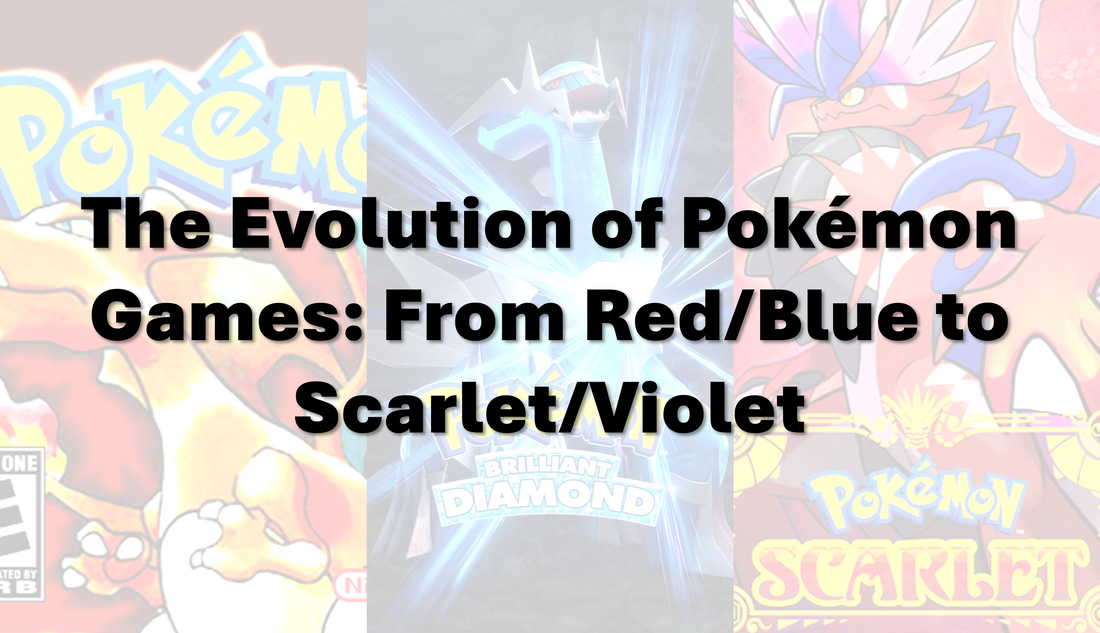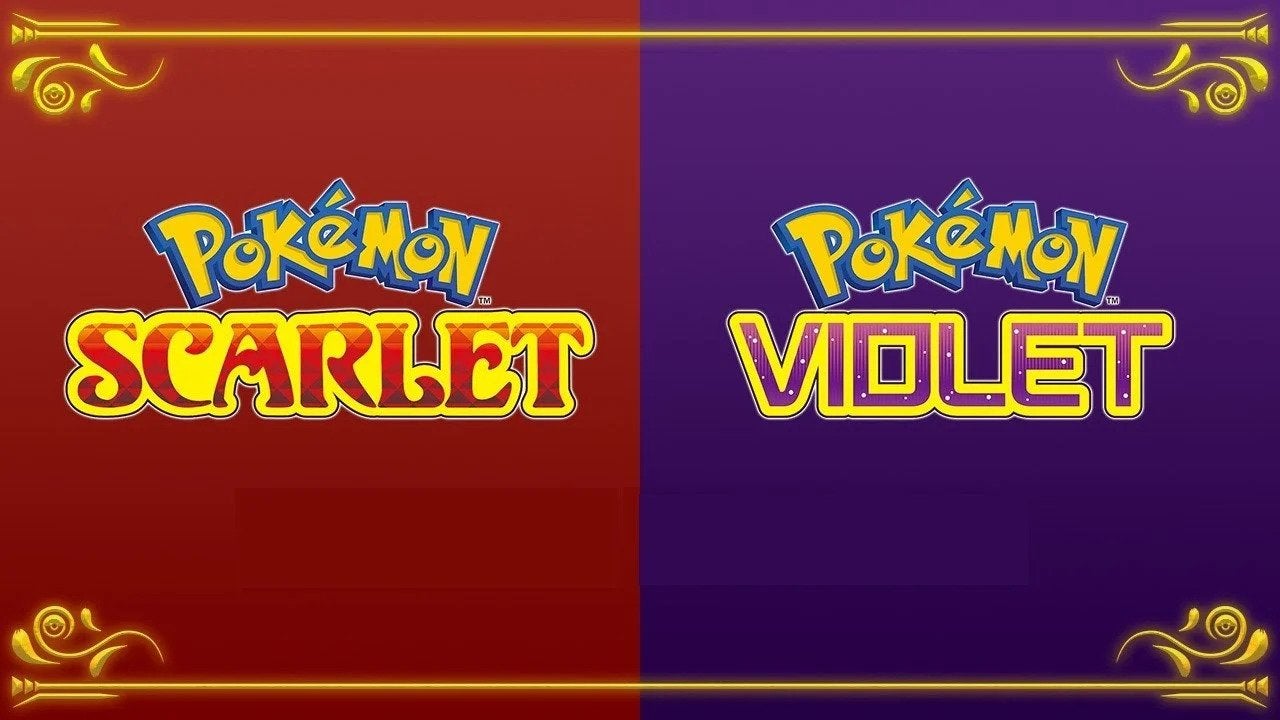
The Evolution of Pokémon Games: From Red/Blue to Scarlet/Violet
Share
Pokémon has been a beloved franchise for decades, captivating millions of players worldwide with its combination of strategy, exploration, and a deep, nostalgic bond with its colorful creatures. Since the release of Pokémon Red and Blue back in 1996, the series has undergone an incredible transformation in both gameplay and technology. In this post, we'll take a journey through the evolution of Pokémon games, tracing the path from the classic Red and Blue to the latest titles, Scarlet and Violet.

1. The Beginning: Pokémon Red and Blue (1996)
When Pokémon Red and Blue first hit the Game Boy in 1996, no one could have predicted the global phenomenon the franchise would become. The games introduced us to the iconic 151 Pokémon and the concept of "Gotta Catch 'Em All!" Players took on the role of a young trainer who traveled across the Kanto region, battling Gym Leaders, facing off against the villainous Team Rocket, and striving to become the Pokémon Champion.
The gameplay was simple but addictive, focusing on turn-based battles, trading Pokémon with friends, and collecting Gym Badges. These games were the foundation of what would become a gaming legacy.

2. The Gold Standard: Pokémon Gold and Silver (1999)
Two years later, Pokémon Gold and Silver took the world by storm on the Game Boy Color. Not only did these games introduce 100 new Pokémon, but they also enhanced the core gameplay with a number of revolutionary features.
For the first time, players could explore two regions: Kanto (from the first games) and Johto. The day-night cycle was introduced, affecting both gameplay and the availability of certain Pokémon. Pokémon could now hold items, and breeding was introduced, adding more depth to team-building and strategy.
Gold and Silver set the standard for what a Pokémon game could be, blending nostalgia with new innovations.

3. The DS Era: Diamond and Pearl (2006)
The Nintendo DS era marked a significant leap forward in both graphics and gameplay. Pokémon Diamond and Pearl brought the series into the 3D realm for the first time (albeit with isometric views). The Sinnoh region introduced new mechanics, such as the Physical/Special Split, which changed the way players approached combat strategy.
One of the standout features of this generation was the introduction of online play, allowing players to trade and battle with friends around the world. This was a game-changer for the competitive scene and helped solidify Pokémon’s place in the global gaming community.

4. The 3DS Revolution: X and Y (2013)
Fast forward to the 3DS era, and Pokémon X and Y represented another massive leap forward. For the first time, the franchise went fully 3D, bringing the world of Pokémon to life in ways that were previously unimaginable. The Kalos region, inspired by France, was a stunning backdrop for the latest adventure.
One of the most significant additions to this generation was the introduction of Mega Evolutions, which allowed Pokémon to temporarily evolve into more powerful forms during battle. The games also introduced the Fairy type, balancing out some of the franchise’s more overpowered types like Dragon.
X and Y were a true turning point for the franchise, with the visuals and mechanics setting the stage for future generations.

5. The Open-World Breakthrough: Pokémon Sword and Shield (2019)
While Pokémon Sword and Shield didn’t offer a true open world in the way some had hoped, they represented a major step in that direction. The Galar region, inspired by the United Kingdom, introduced the Wild Area, a vast open space where players could explore freely, battle Dynamax Pokémon, and catch a wide range of species.
Dynamaxing was another new feature, allowing Pokémon to grow to massive sizes and unleash powerful moves. The games also introduced a new competitive format with the introduction of the Battle Stadium and online features that let players participate in ranked battles.
While the game wasn’t universally praised, it was clear that Game Freak was taking steps toward evolving the series with new ideas, and it set the stage for the future.

6. The Future: Pokémon Scarlet and Violet (2022)
With Scarlet and Violet, Pokémon has finally entered the world of truly open-world gaming. For the first time in the series’ history, players are free to explore the vast Paldea region without restrictive linear progression. This shift in design allows trainers to approach the game however they see fit, whether it's challenging Gyms in any order, completing side quests, or uncovering hidden secrets in the open world.
The addition of the Terastal phenomenon—where Pokémon can change their type temporarily during battle—brings a new layer of strategy to both competitive and casual play. The inclusion of co-op multiplayer also means players can explore together, trading and battling in real-time.
In terms of visuals, Scarlet and Violet push the limits of the Nintendo Switch, offering expansive landscapes and immersive environments. While the games have faced some technical issues, the ambition and scope of these titles mark a bold new era for Pokémon.
7. Looking Ahead: What's Next for Pokémon?
With Scarlet and Violet ushering in a new era of open-world gameplay, the future of Pokémon looks bright. Fans are hoping that Game Freak will continue to refine the open-world experience and address some of the technical concerns. Additionally, there are whispers of future expansions and new Pokémon regions to explore.
The franchise's blend of nostalgia and innovation has kept it relevant for nearly three decades, and it’s clear that the Pokémon formula will continue to evolve, always striving to meet the expectations of both old fans and new generations.
From the pixelated battles of Red and Blue to the sprawling landscapes of Scarlet and Violet, Pokémon has come a long way. The franchise has always managed to capture the hearts of players by blending nostalgia with innovation. Whether you’re a long-time fan or a newcomer to the series, there’s always something new to discover in the world of Pokémon.
